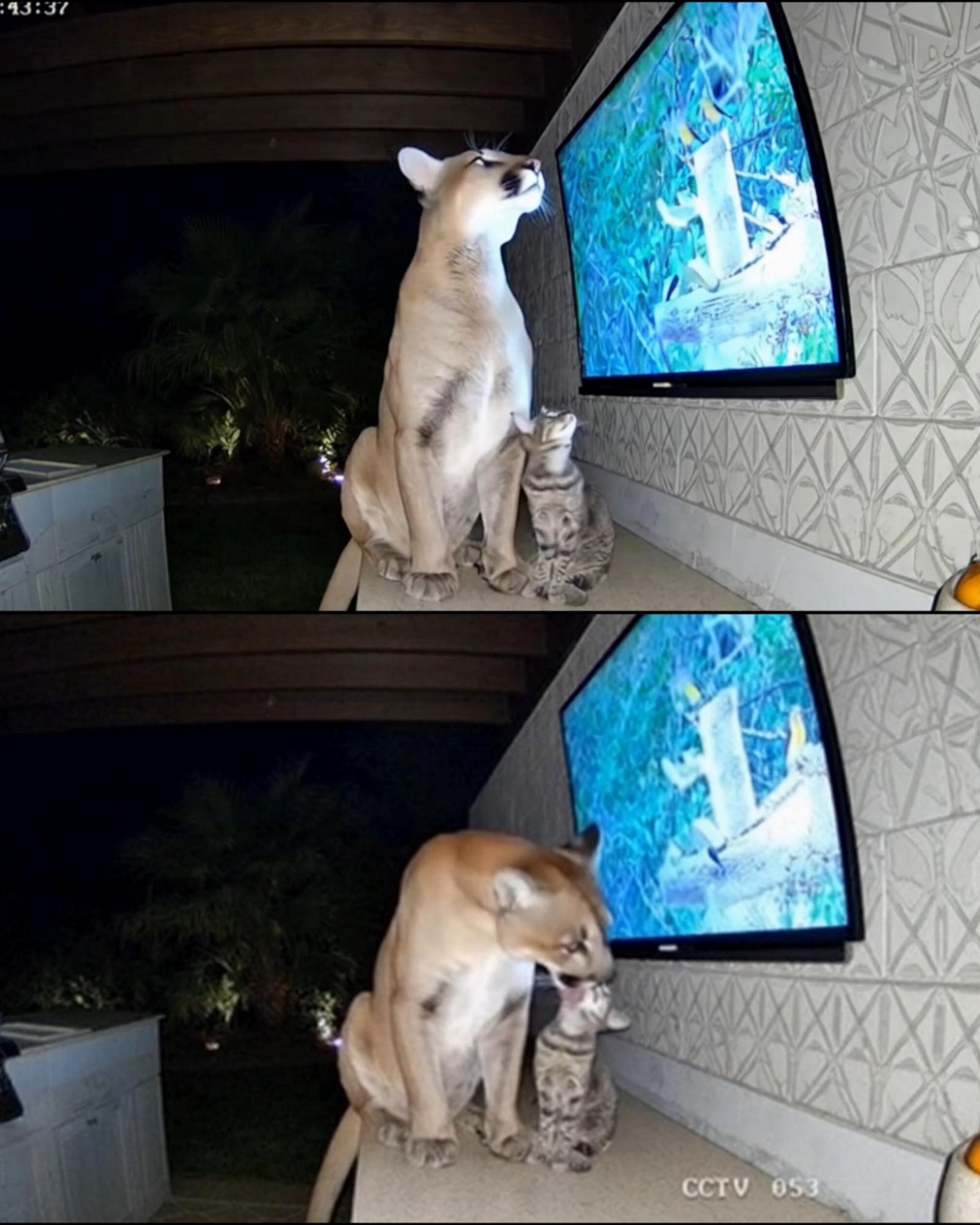It started as one of those stories no one quite believes at first — the kind you think must be an exaggeration, a blurry photo, or a wild internet rumor.
But the footage was real.
And it was stranger — and somehow sweeter — than anyone expected.
It happened in the still hours before dawn, when the streets were empty and the mountains beyond the neighborhood slept under a soft silver fog. A motion-sensing camera on a quiet suburban patio flickered to life, its lens focused on a small wooden table near a sliding glass door.
There, perched side by side like old friends, sat two very different creatures.
On the left: a small gray tabby house cat, tail flicking lazily, eyes wide with fascination.
On the right: a full-grown mountain lion — muscles taut beneath her tawny coat, paws the size of dinner plates, eyes fixed intently on the same glowing screen.
The two of them were watching “Cat TV.”

For anyone unfamiliar, “Cat TV” is a kind of entertainment designed for indoor pets — looping videos of birds, squirrels, and fluttering butterflies meant to keep house cats stimulated and happy. It was this exact program that was playing on the outdoor television the night the camera caught the pair.
The scene looked almost peaceful — absurdly domestic, even.
A predator of the wild and a pampered household pet, both entranced by digital songbirds fluttering across the screen.
The tabby’s owner, a woman named Marissa, had set the screen up for her cat, Whiskers, who loved to sit outside in the evenings.
When she woke the next morning and checked her motion alerts, she expected the usual raccoon or opossum.
What she found instead made her drop her coffee.
She watched the clip over and over — the mountain lion walking gracefully out of the shadows, her movements silent and fluid. She paused when she spotted Whiskers, tilted her head curiously, and then, without hesitation, jumped onto the patio table.
The cat didn’t run.
The lion didn’t attack.
Instead, they both stared at the TV, their eyes reflecting the same flickering light.
Then came the part that made everyone gasp.
The mountain lion leaned forward, her massive head lowering beside the tiny tabby — and ever so gently, she licked the smaller cat’s head.
Just once.
A soft, slow, deliberate motion — almost maternal.
Wildlife officials reviewing the video later said the behavior was extremely unusual.
“It’s possible,” one researcher explained, “that the mountain lion is a female who’s recently lost a cub or separated from her litter. The scent, size, or movement of the domestic cat may have triggered her maternal instincts.”
In other words — she may have thought Whiskers was her baby.
The footage supported that theory. After the brief lick, the mountain lion didn’t leave immediately. She stayed near the patio for nearly twenty minutes, glancing between the screen and the small cat beside her, as though guarding it.
At one point, Whiskers even stretched and rubbed against her — the way cats do when they feel comfortable. It was an impossible image: two species, separated by evolution and instinct, bound together by something soft and universal — curiosity, comfort, maybe even affection.
When the lion finally left, she didn’t retreat in fear.
She walked calmly back into the woods, glancing once over her shoulder toward the house.

By morning, the neighborhood was buzzing.
The clip spread through local social media pages first — “MOUNTAIN LION WATCHES TV WITH HOUSE CAT,” one post read, already shared hundreds of times. Soon, national outlets were calling. The footage was surreal — cinematic — the kind of moment that makes people forget for a second how wild the wild truly is.
But for wildlife experts, the story carried a note of warning.
“This isn’t aggression,” explained Dr. Elena Ruiz, a researcher with the state’s Department of Wildlife. “But it is attachment. If this lion perceives the domestic cat as her cub, she might return. And a protective mother mountain lion can be dangerous — not out of malice, but out of instinct.”
Officials quickly notified residents to keep their pets indoors for several days and avoid leaving food or water outside. Marissa moved the “Cat TV” screen inside — though she admits Whiskers sat by the window for nights afterward, staring out as if waiting for her new friend to return.
In the following weeks, motion sensors along the ridge recorded the lion passing through the area twice — both times near the same backyard.
She didn’t approach the house again, but lingered briefly in the treeline before disappearing.
“She’s probably checking,” one ranger said. “Making sure her ‘cub’ is safe.”
The idea tugged at something deep in people’s hearts. The footage wasn’t just fascinating; it was hauntingly tender. It reminded everyone watching that the distance between wild and tame isn’t always as wide as we imagine.
Because love — or whatever force drives a mother to protect, nurture, and stay — doesn’t belong only to humans.
Sometimes it wears claws and fur and lives in the mountains.

Months later, Marissa still keeps the footage saved on her phone.
She’s shown it to reporters, friends, even wildlife officials who visit the area. Each time, the reaction is the same — disbelief, followed by quiet wonder.
In interviews, she often says the same thing:
“She wasn’t scary. She was gentle. It was like watching a mother remember something she’d lost.”
Maybe that’s what makes the clip so powerful — it blurs the lines between instinct and emotion, between predator and protector.
Because for those twenty silent minutes in a backyard bathed in moonlight, two lives met on equal ground.
Not as hunter and prey, but as creatures moved by the same small miracle — connection.




